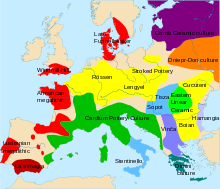Danubian culture
This article includes alist of references,related reading,orexternal links,but its sources remain unclear because it lacksinline citations.(December 2009) |
This articlerelies largely or entirely on asingle source.(June 2024) |
The termDanubianculturewas coined by the Australian archaeologistVere Gordon Childeto describe the first agrarian society inCentral EuropeandEastern Europe.It covers theLinear Pottery culture(Linearbandkeramik, LBK),stroked potteryandRössen cultures.
The beginning of the Linear Pottery culture dates to around5500 BC.It appears to have spread westwards along the valley of the riverDanubeand interacted with the cultures ofAtlantic Europewhen they reached theParis Basin.

Danubian I peoples cleared forests and cultivated fertileloesssoils from theBalkansto theLow Countriesand theParis Basin.They made LBK pottery and kept domesticatedcows,pigs,dogs,sheep,andgoats.The characteristictoolof the culture is theshoe-last celt,a kind of long thin stoneadzewhich was used to fell trees and sometimes as a weapon, evidenced by the skulls found atTalheim, Neckarin Germany andSchletzin Austria. Settlements consisted oflonghouses.According to a theory byEduard Sangmeister,these settlements were abandoned, possibly as fertile land was exhausted, and then reoccupied perhaps when the land had lainfallowfor long enough. In contrast,Peter ModdermanandJens Lüningbelieve the settlements were constantly inhabited, with individual families using specific plots (Hofplätze). They also importedspondylusshells from theMediterranean.
A second wave of the culture, which used painted pottery withAsiaticinfluences, superseded the first phase starting around 4500 BC. This was followed by a third wave which usedstroke-ornamented ware.
Danubian sites include those atBylanyinBohemiaandKöln-LindenthalinGermany.
See also
[edit]
